weight MAZDA MODEL RX 8 2006 (in English) Owner's Manual
[x] Cancel search | Manufacturer: MAZDA, Model Year: 2006, Model line: MODEL RX 8, Model: MAZDA MODEL RX 8 2006Pages: 434
Page 147 of 434

Black plate (147,1)
If the vehicle is kicked down at the
following speeds or lower, the gears shift
down automatically:
Gear Vehicle speed
M6→M5 210 km/h (130 mph)
M6→M4 175 km/h (108 mph)
M5→M4 175 km/h (108 mph)
Recommendations for shifting
Upshifting
For normal acceleration and cruising, we
recommend these shift points.
Gear Vehicle speed
M1 to M2 19 km/h (12 mph)
M2 to M3 35 km/h (22 mph)
M3 to M4 47 km/h (29 mph)
M4 to M5 58 km/h (36 mph)
M5 to M6 78 km/h (49 mph)
For cruising
Gear Vehicle speed
M1 to M2 5 km/h (3 mph)
M2 to M3 30 km/h (19 mph)
M3 to M4 40 km/h (25 mph)
M4 to M5 50 km/h (31 mph)
M5 to M6 67 km/h (42 mph)
Downshifting
When you must slow down in heavy
traffic or on a steepupgrade, downshift
before the engine starts to overwork. This
gives better acceleration when you need
more speed.
On a steepdowngrade, downshifting
helps maintain safe speed and prolongs
brake life.
qDriving Tips
Passing
For extra power when passing another
vehicle or climbing steep grades, depress
the accelerator fully. The transmission will
shift to a lower gear, depending on vehicle
speed.
Climbing steep grades from a stop
To climb a steep grade from a stopped
position:
1. Depress the brake pedal.
2. Shift to D or M1, depending on the
load weight and grade steepness.
3. Release the brake pedal while
gradually accelerating.
Descending steep grades
When descending a steep grade, shift to
lower gears, depending on load weight
and grade steepness. Descend slowly,
using the brakes only occasionally to
prevent them from overheating.
Driving Your Mazda
Starting and Driving
5-17
RX-8_8U58-EA-05J_Edition1 Page147
Thursday, August 25 2005 4:54 PM
Form No.8U58-EA-05J
Page 185 of 434
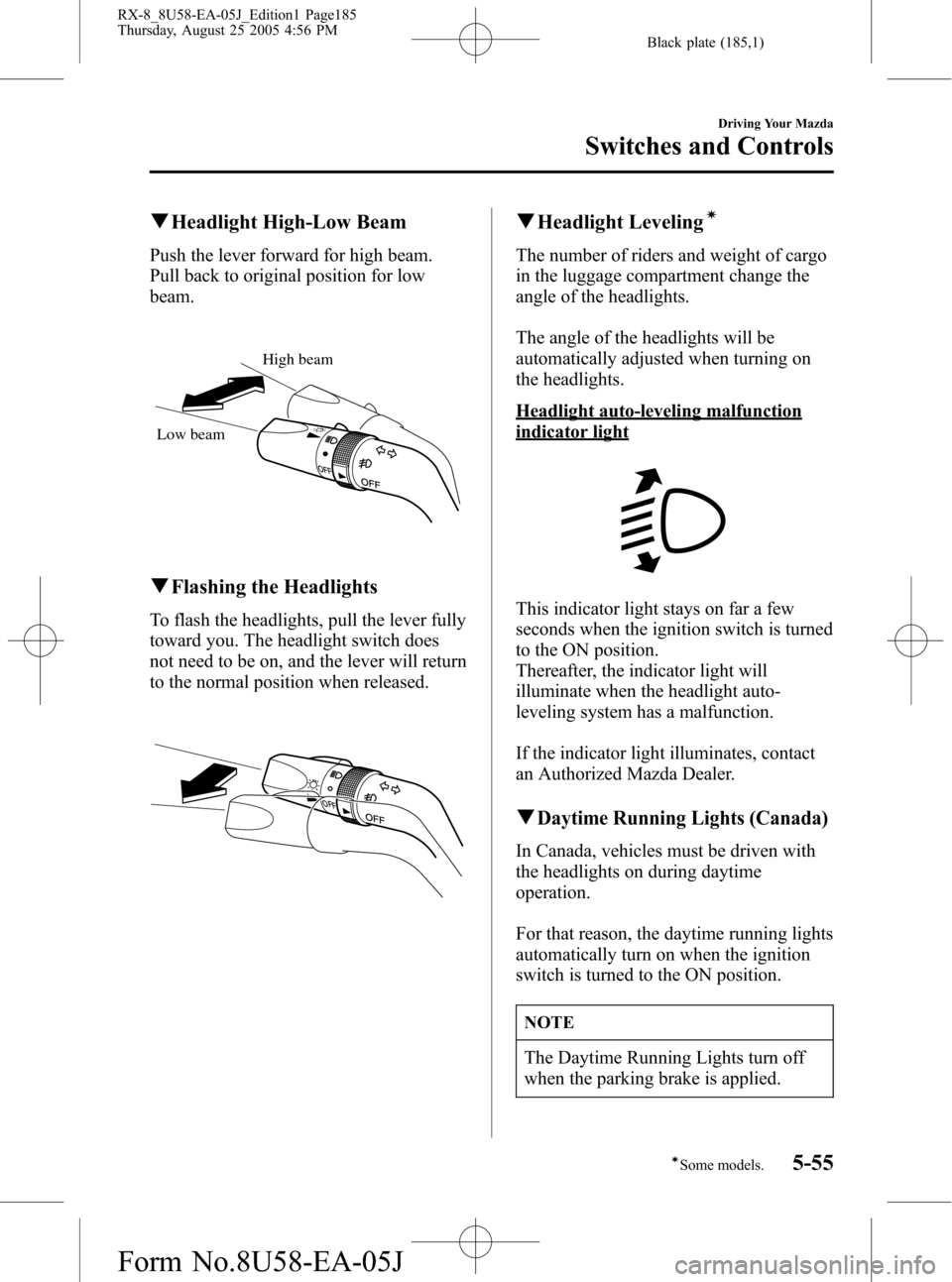
Black plate (185,1)
qHeadlight High-Low Beam
Push the lever forward for high beam.
Pull back to original position for low
beam.
High beam
Low beam
qFlashing the Headlights
To flash the headlights, pull the lever fully
toward you. The headlight switch does
not need to be on, and the lever will return
to the normal position when released.
qHeadlight Levelingí
The number of riders and weight of cargo
in the luggage compartment change the
angle of the headlights.
The angle of the headlights will be
automatically adjusted when turning on
the headlights.
Headlight auto-leveling malfunction
indicator light
This indicator light stays on far a few
seconds when the ignition switch is turned
to the ON position.
Thereafter, the indicator light will
illuminate when the headlight auto-
leveling system has a malfunction.
If the indicator light illuminates, contact
an Authorized Mazda Dealer.
qDaytime Running Lights (Canada)
In Canada, vehicles must be driven with
the headlights on during daytime
operation.
For that reason, the daytime running lights
automatically turn on when the ignition
switch is turned to the ON position.
NOTE
The Daytime Running Lights turn off
when the parking brake is applied.
Driving Your Mazda
Switches and Controls
5-55íSome models. RX-8_8U58-EA-05J_Edition1 Page185
Thursday, August 25 2005 4:56 PM
Form No.8U58-EA-05J
Page 301 of 434
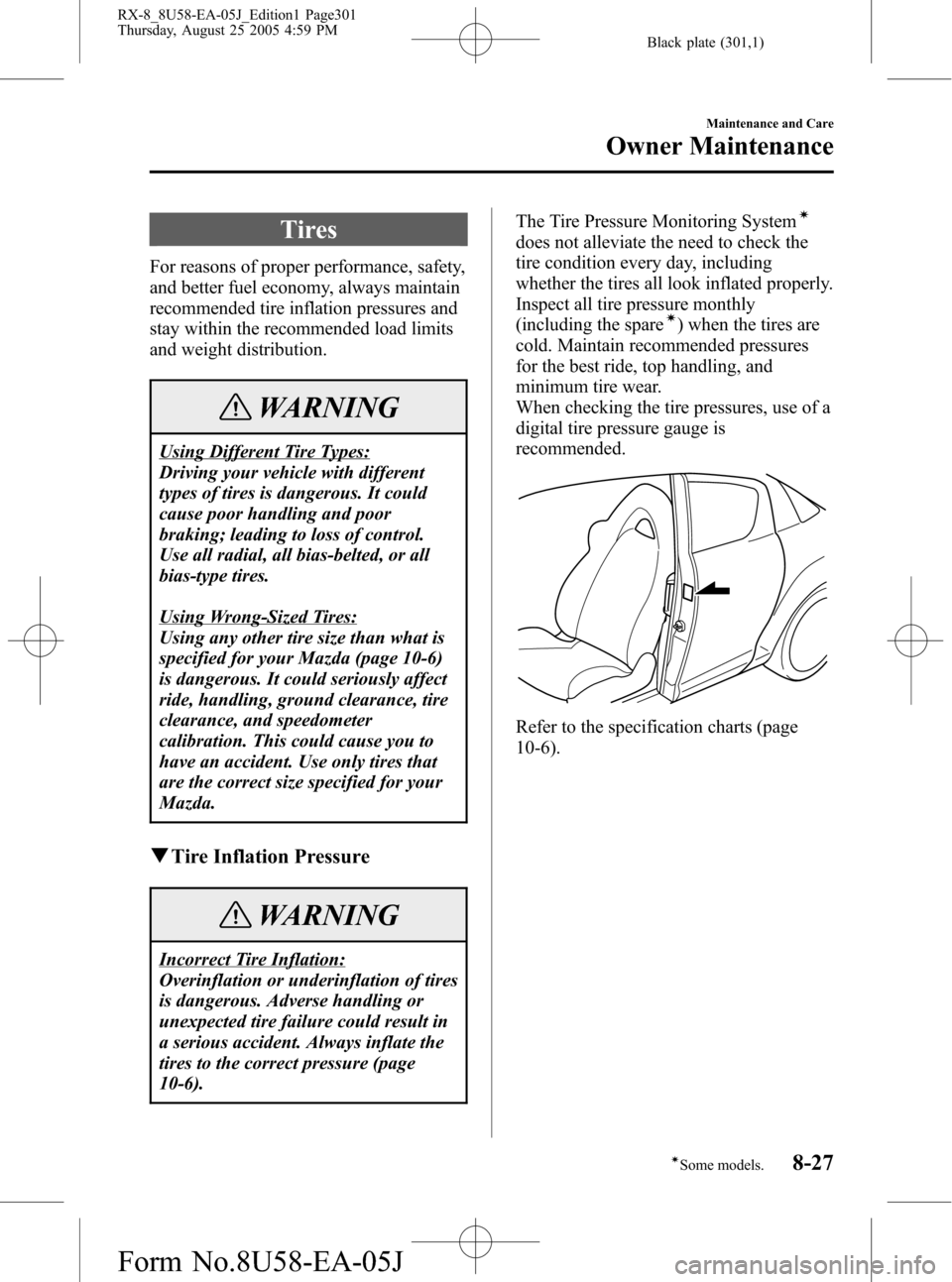
Black plate (301,1)
Tires
For reasons of proper performance, safety,
and better fuel economy, always maintain
recommended tire inflation pressures and
stay within the recommended load limits
and weight distribution.
WARNING
Using Different Tire Types:
Driving your vehicle with different
types of tires is dangerous. It could
cause poor handling and poor
braking; leading to loss of control.
Use all radial, all bias-belted, or all
bias-type tires.
Using Wrong-Sized Tires:
Using any other tire size than what is
specified for your Mazda (page 10-6)
is dangerous. It could seriously affect
ride, handling, ground clearance, tire
clearance, and speedometer
calibration. This could cause you to
have an accident. Use only tires that
are the correct size specified for your
Mazda.
qTire Inflation Pressure
WARNING
Incorrect Tire Inflation:
Overinflation or underinflation of tires
is dangerous. Adverse handling or
unexpected tire failure could result in
a serious accident. Always inflate the
tires to the correct pressure (page
10-6).The Tire Pressure Monitoring System
í
does not alleviate the need to check the
tire condition every day, including
whether the tires all look inflated properly.
Inspect all tire pressure monthly
(including the spare
í) when the tires are
cold. Maintain recommended pressures
for the best ride, top handling, and
minimum tire wear.
When checking the tire pressures, use of a
digital tire pressure gauge is
recommended.
Refer to the specification charts (page
10-6).
Maintenance and Care
Owner Maintenance
8-27íSome models. RX-8_8U58-EA-05J_Edition1 Page301
Thursday, August 25 2005 4:59 PM
Form No.8U58-EA-05J
Page 343 of 434
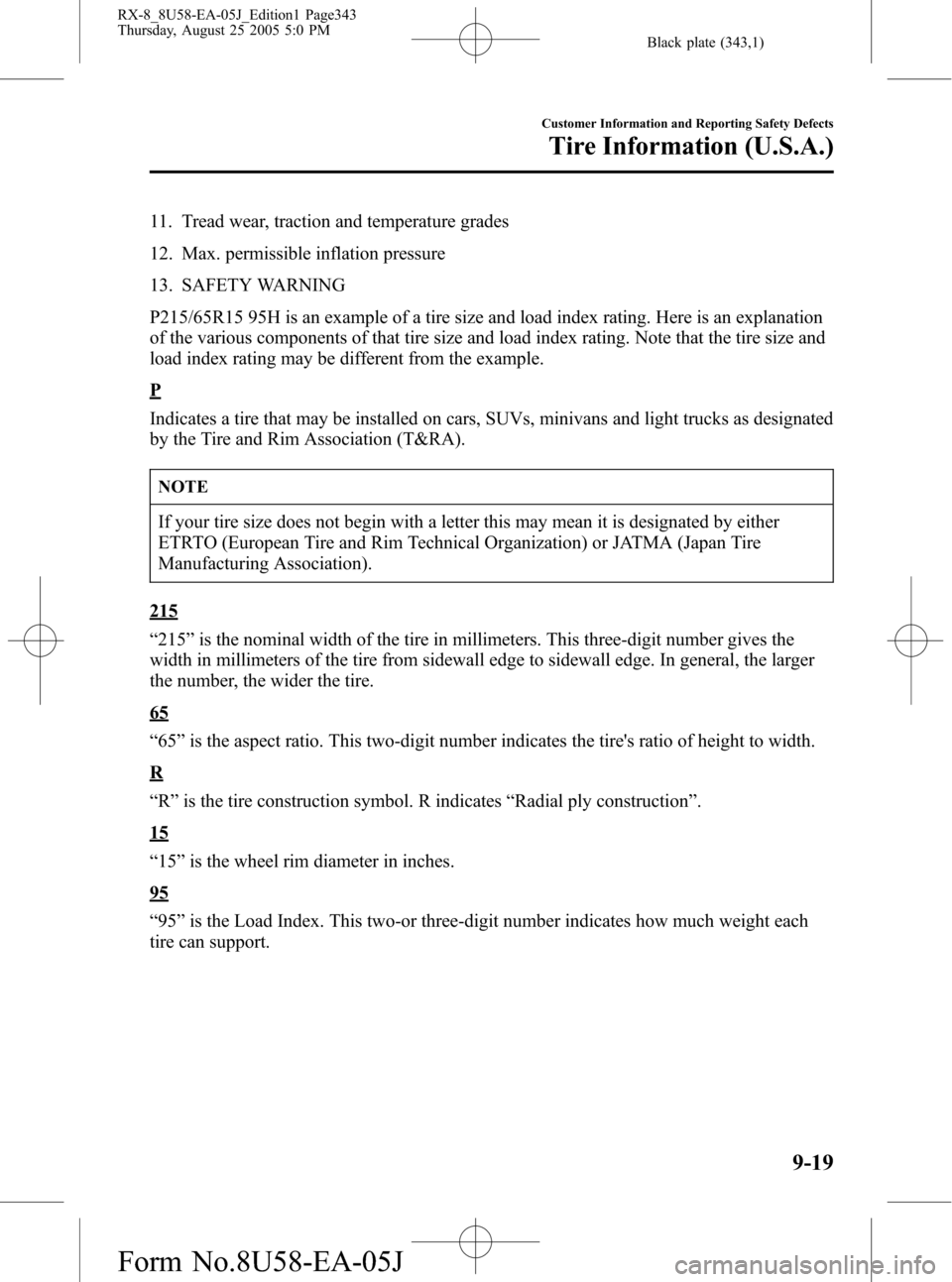
Black plate (343,1)
11. Tread wear, traction and temperature grades
12. Max. permissible inflation pressure
13. SAFETY WARNING
P215/65R15 95H is an example of a tire size and load index rating. Here is an explanation
of the various components of that tire size and load index rating. Note that the tire size and
load index rating may be different from the example.
P
Indicates a tire that may be installed on cars, SUVs, minivans and light trucks as designated
by the Tire and Rim Association (T&RA).
NOTE
If your tire size does not begin with a letter this may mean it is designated by either
ETRTO (European Tire and Rim Technical Organization) or JATMA (Japan Tire
Manufacturing Association).
215
“215”is the nominal width of the tire in millimeters. This three-digit number gives the
width in millimeters of the tire from sidewall edge to sidewall edge. In general, the larger
the number, the wider the tire.
65
“65”is the aspect ratio. This two-digit number indicates the tire's ratio of height to width.
R
“R”is the tire construction symbol. R indicates“Radial ply construction”.
15
“15”is the wheel rim diameter in inches.
95
“95”is the Load Index. This two-or three-digit number indicates how much weight each
tire can support.
Customer Information and Reporting Safety Defects
Tire Information (U.S.A.)
9-19
RX-8_8U58-EA-05J_Edition1 Page343
Thursday, August 25 2005 5:0 PM
Form No.8U58-EA-05J
Page 344 of 434

Black plate (344,1)
H
“H”is the speed rating. The speed rating denotes the maximum speed for which the use of
the tire is rated.
Letter Rating Speed Rating
Q 99 mph
R 106 mph
S 112 mph
T 118 mph
U 124 mph
H 130 mph
V 149 mph
W 168
*mph
Y 186*mph
* For tires with a maximum speed capability over 149 mph, tire manufacturers sometimes use the letters ZR. For
tires with a maximum speed capability over 186 mph, tire manufacturers always use the letters ZR.
M+S or M/S: Mud and Snow
AT: All Terrain.
AS: All Season. The“M+S”or“M/S”indicates that the tire has some functional use in
mud and snow.
U.S. DOT Tire Identification Number (TIN)
This begins with the letters“DOT”which indicates the tire meets all federal standards. The
next two numbers or letters are the plant code where it was manufactured, and the last four
numbers represent the week and year the tire was manufactured. For example, the numbers
457 means the 45st week of 1997. After 2000 the numbers go to four digits. For example,
the number 2102 means the 21th week of 2002. The other numbers are marketing codes
used at the manufacturer's discretion. This information is used to contact consumers if a tire
defect requires a recall.
Tire Ply Composition and Materials Used
The number of plies indicates the number of layers of rubber-coated fabric in the tire. In
general, the greater the number of plies, the more weight a tire can support. Tire
manufacturers also must indicate the tire materials, which include steel, nylon, polyester,
and other.
Maximum Load Rating
This number indicates the maximum load in kilograms and pounds that can be carried by
the tire.
Maximum Permissible Inflation Pressure
This number is the greatest amount of air pressure that should ever be put in the tire under
normal driving conditions.
9-20
Customer Information and Reporting Safety Defects
Tire Information (U.S.A.)
RX-8_8U58-EA-05J_Edition1 Page344
Thursday, August 25 2005 5:0 PM
Form No.8U58-EA-05J
Page 350 of 434
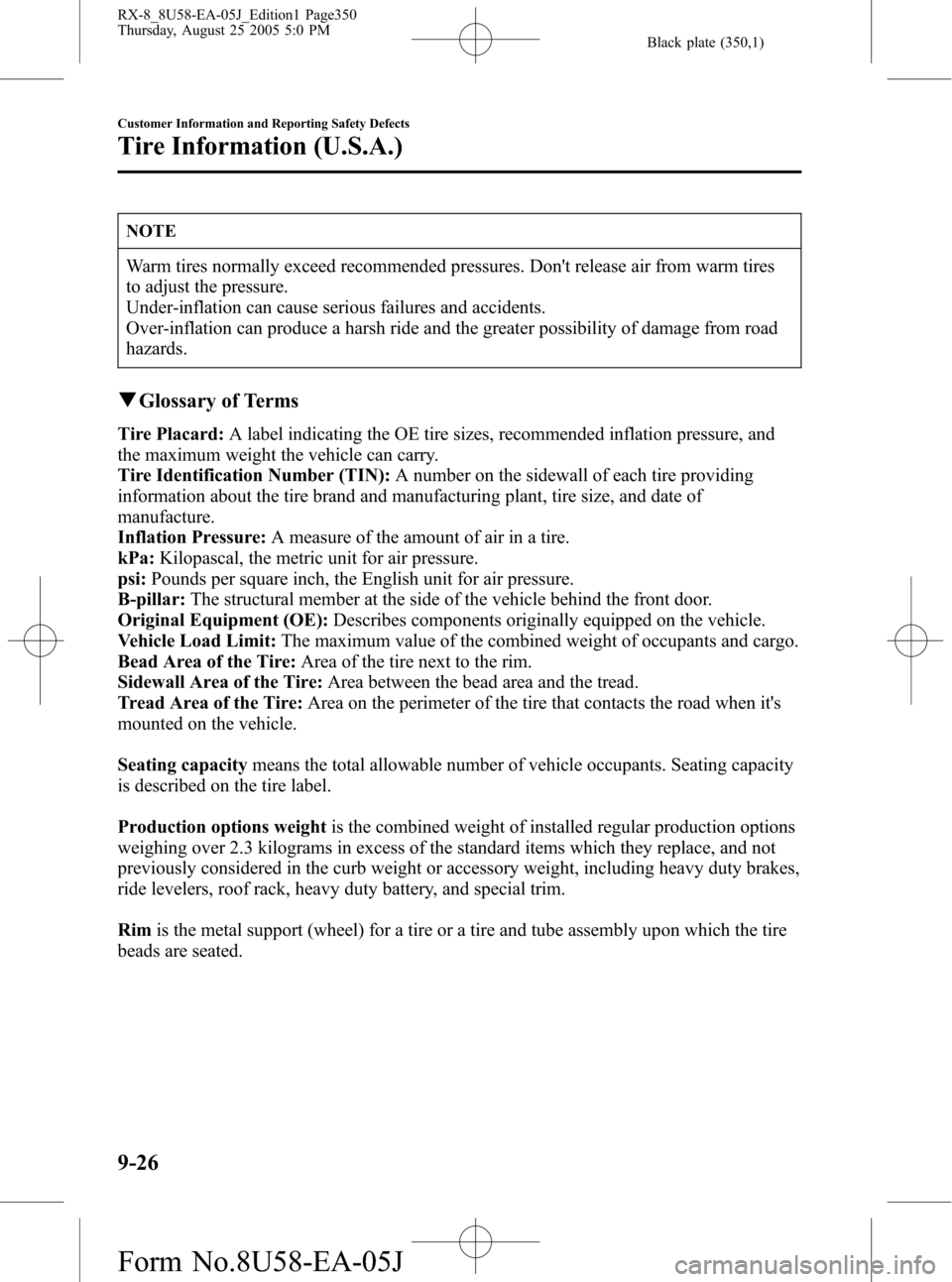
Black plate (350,1)
NOTE
Warm tires normally exceed recommended pressures. Don't release air from warm tires
to adjust the pressure.
Under-inflation can cause serious failures and accidents.
Over-inflation can produce a harsh ride and the greater possibility of damage from road
hazards.
qGlossary of Terms
Tire Placard:A label indicating the OE tire sizes, recommended inflation pressure, and
the maximum weight the vehicle can carry.
Tire Identification Number (TIN):A number on the sidewall of each tire providing
information about the tire brand and manufacturing plant, tire size, and date of
manufacture.
Inflation Pressure:A measure of the amount of air in a tire.
kPa:Kilopascal, the metric unit for air pressure.
psi:Pounds per square inch, the English unit for air pressure.
B-pillar:The structural member at the side of the vehicle behind the front door.
Original Equipment (OE):Describes components originally equipped on the vehicle.
Vehicle Load Limit:The maximum value of the combined weight of occupants and cargo.
Bead Area of the Tire:Area of the tire next to the rim.
Sidewall Area of the Tire:Area between the bead area and the tread.
Tread Area of the Tire:Area on the perimeter of the tire that contacts the road when it's
mounted on the vehicle.
Seating capacitymeans the total allowable number of vehicle occupants. Seating capacity
is described on the tire label.
Production options weightis the combined weight of installed regular production options
weighing over 2.3 kilograms in excess of the standard items which they replace, and not
previously considered in the curb weight or accessory weight, including heavy duty brakes,
ride levelers, roof rack, heavy duty battery, and special trim.
Rimis the metal support (wheel) for a tire or a tire and tube assembly upon which the tire
beads are seated.
9-26
Customer Information and Reporting Safety Defects
Tire Information (U.S.A.)
RX-8_8U58-EA-05J_Edition1 Page350
Thursday, August 25 2005 5:0 PM
Form No.8U58-EA-05J
Page 354 of 434

Black plate (354,1)
Vehicle Loading
NOTE
This vehicle is not designed to tow a trailer.
This section will guide you in the proper loading of your vehicle and/or trailer, to keep
your loaded vehicle weight within its design rating capability, with or without a trailer.
Properly loading your vehicle will provide maximum return of vehicle design performance.
Before loading your vehicle, familiarize yourself with the following terms for determining
your vehicle's weight ratings, with or without a trailer, from the vehicle's Safety
Certification Label and Tire and Load Information Label:
WARNING
Overloaded Vehicle:
Overloading a vehicle is dangerous. The results of overloading can have serious
consequences in terms of passenger safety. Too much weight on a vehicle's suspension
system can cause spring or shock absorber failure, brake failure, handling or steering
problems, irregular tire wear, tire failure or other damage.
Overloading makes a vehicle harder to drive and control. It also increases the distance
required for stopping. In cases of serious overloading, brakes can fail completely,
particularly on steep grades. The load a tire will carry safely is a combination of the
size of the tire, its load range, and corresponding inflation pressure.
Never overload the vehicle and always observe the vehicle's weight ratings from the
vehicle's Safety Certification and Tire and Load Information labels.
Base Curb Weight is the weight of the vehicle including a full tank of fuel and all
standard equipment. It does not include passengers, cargo, or optional equipment.
9-30
Customer Information and Reporting Safety Defects
Tire Information (U.S.A.)
RX-8_8U58-EA-05J_Edition1 Page354
Thursday, August 25 2005 5:0 PM
Form No.8U58-EA-05J
Page 355 of 434
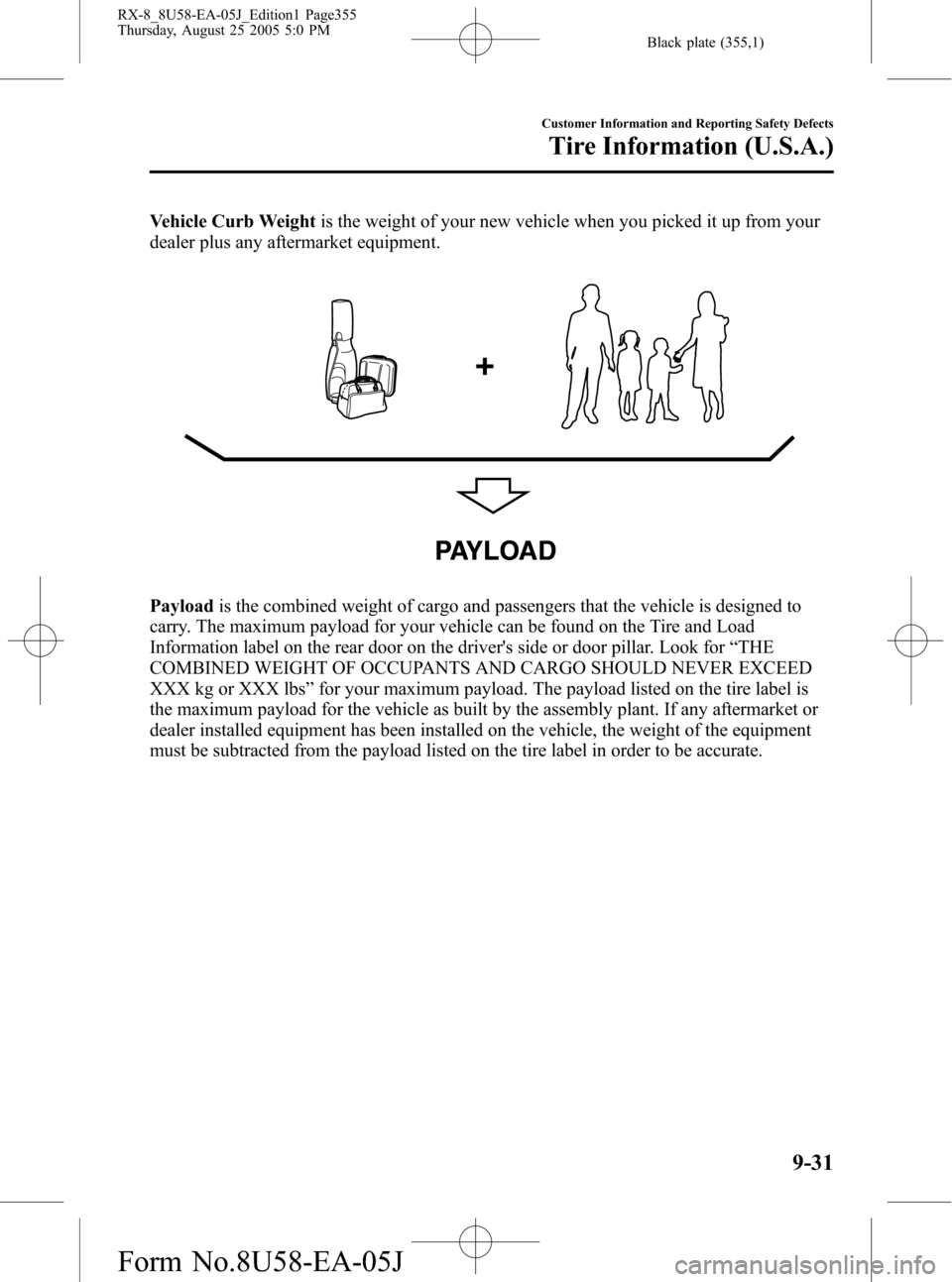
Black plate (355,1)
Vehicle Curb Weightis the weight of your new vehicle when you picked it up from your
dealer plus any aftermarket equipment.
PAYLOAD
Payloadis the combined weight of cargo and passengers that the vehicle is designed to
carry. The maximum payload for your vehicle can be found on the Tire and Load
Information label on the rear door on the driver's side or door pillar. Look for“THE
COMBINED WEIGHT OF OCCUPANTS AND CARGO SHOULD NEVER EXCEED
XXX kg or XXX lbs”for your maximum payload. The payload listed on the tire label is
the maximum payload for the vehicle as built by the assembly plant. If any aftermarket or
dealer installed equipment has been installed on the vehicle, the weight of the equipment
must be subtracted from the payload listed on the tire label in order to be accurate.
Customer Information and Reporting Safety Defects
Tire Information (U.S.A.)
9-31
RX-8_8U58-EA-05J_Edition1 Page355
Thursday, August 25 2005 5:0 PM
Form No.8U58-EA-05J
Page 356 of 434
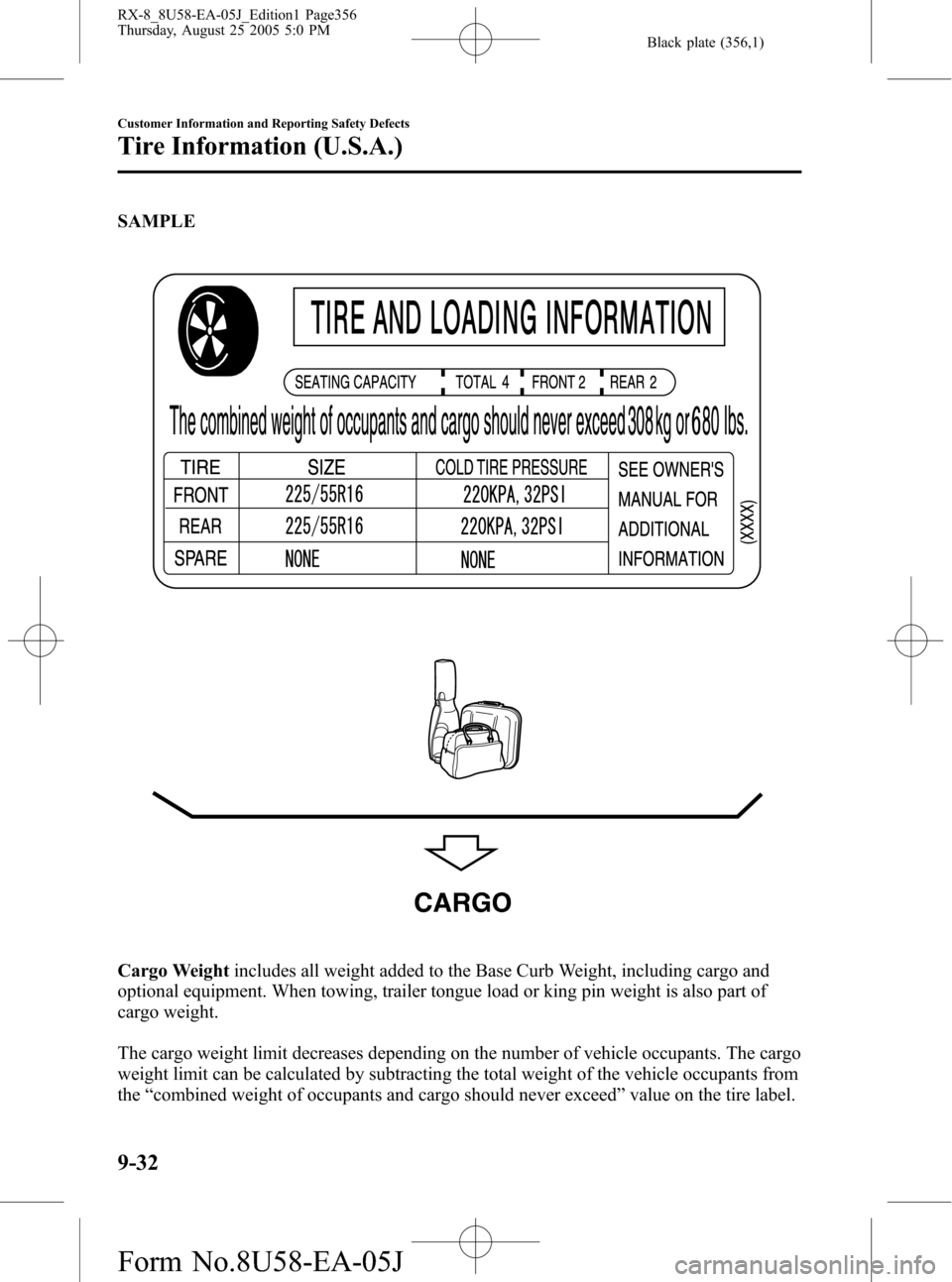
Black plate (356,1)
SAMPLE
CARGO
Cargo Weightincludes all weight added to the Base Curb Weight, including cargo and
optional equipment. When towing, trailer tongue load or king pin weight is also part of
cargo weight.
The cargo weight limit decreases depending on the number of vehicle occupants. The cargo
weight limit can be calculated by subtracting the total weight of the vehicle occupants from
the“combined weight of occupants and cargo should never exceed”value on the tire label.
9-32
Customer Information and Reporting Safety Defects
Tire Information (U.S.A.)
RX-8_8U58-EA-05J_Edition1 Page356
Thursday, August 25 2005 5:0 PM
Form No.8U58-EA-05J
Page 357 of 434
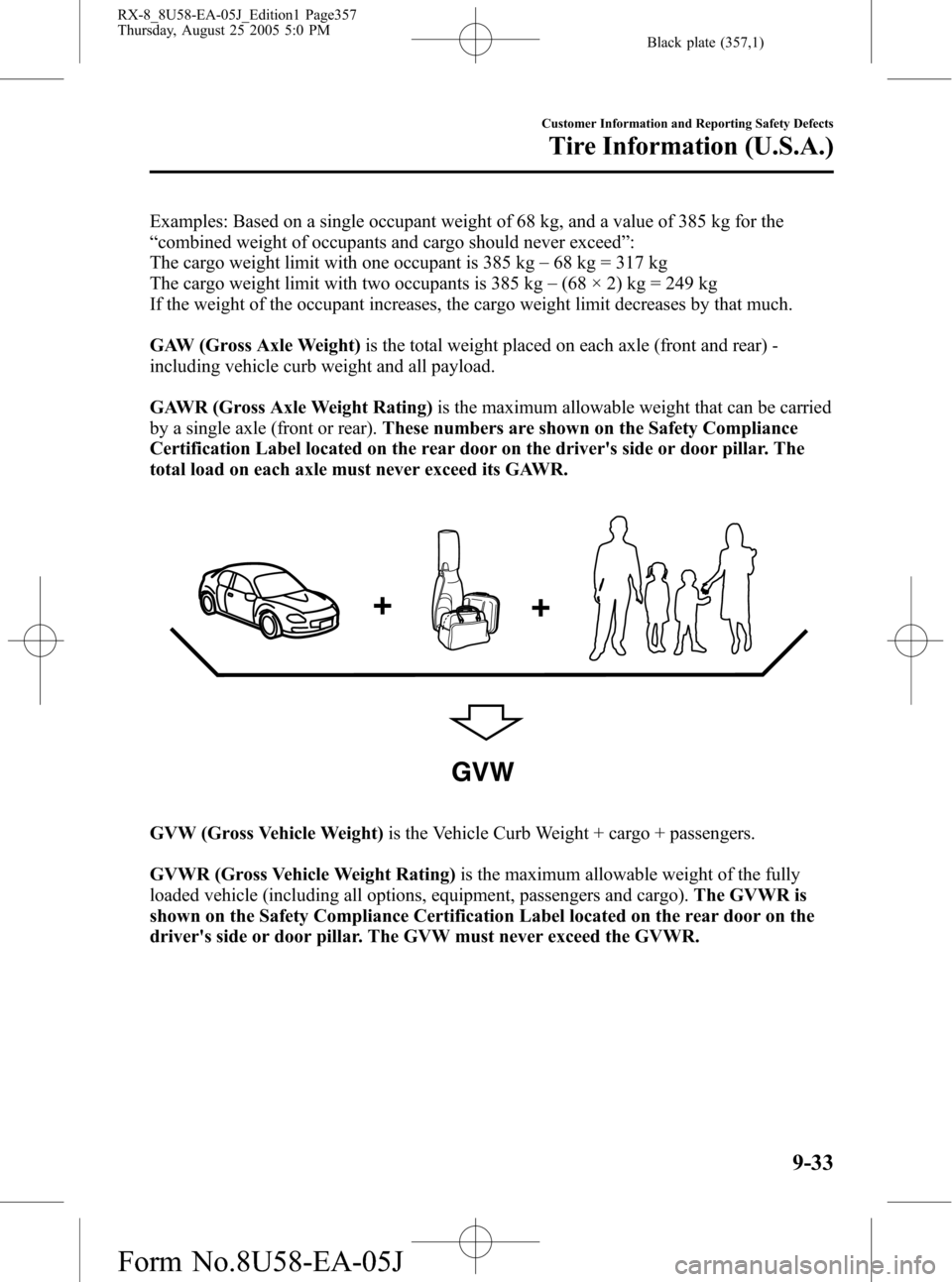
Black plate (357,1)
Examples: Based on a single occupant weight of 68 kg, and a value of 385 kg for the
“combined weight of occupants and cargo should never exceed”:
The cargo weight limit with one occupant is 385 kg_
68 kg = 317 kg
The cargo weight limit with two occupants is 385 kg_
(68 × 2) kg = 249 kg
If the weight of the occupant increases, the cargo weight limit decreases by that much.
GAW (Gross Axle Weight)is the total weight placed on each axle (front and rear) -
including vehicle curb weight and all payload.
GAWR (Gross Axle Weight Rating)is the maximum allowable weight that can be carried
by a single axle (front or rear).These numbers are shown on the Safety Compliance
Certification Label located on the rear door on the driver's side or door pillar. The
total load on each axle must never exceed its GAWR.
GVW
GVW (Gross Vehicle Weight)is the Vehicle Curb Weight + cargo + passengers.
GVWR (Gross Vehicle Weight Rating)is the maximum allowable weight of the fully
loaded vehicle (including all options, equipment, passengers and cargo).The GVWR is
shown on the Safety Compliance Certification Label located on the rear door on the
driver's side or door pillar. The GVW must never exceed the GVWR.
Customer Information and Reporting Safety Defects
Tire Information (U.S.A.)
9-33
RX-8_8U58-EA-05J_Edition1 Page357
Thursday, August 25 2005 5:0 PM
Form No.8U58-EA-05J